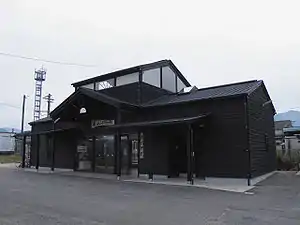Ōkawano Station
Ōkawano Station (大川野駅, Ōkawano-eki) is a railway station in Ōkawa-machi Ōkawano, Imari, Saga Prefecture, Japan. It is operated by JR Kyushu and is on the Chikuhi Line.[1][2]
Ōkawano Station 大川野駅 | |
|---|---|
 Ōkawano Station in 2008 | |
| Location | Ōkawa-machi Ōkawano, Imari-shi, Saga-ken Japan |
| Coordinates | 33°18′27″N 129°58′37″E |
| Operated by | |
| Line(s) | ■ Chikuhi Line |
| Distance | 12.9 km from Yamamoto |
| Platforms | 1 island platform |
| Tracks | 2 + 2 sidings |
| Construction | |
| Structure type | At grade |
| Parking | Available |
| Bicycle facilities | Bike shed |
| Other information | |
| Status | Unstaffed |
| Website | Official website |
| History | |
| Opened | 1 March 1935 |
| Passengers | |
| FY2015 | 41 daily |
| Location | |
 Ōkawano Station Location within Japan | |
Lines
The station is served by the western section of the Chikuhi Line and is 12.9 km from the starting point of this section at Yamamoto. Besides the terminal at Yamamoto, the station is the only place on this section of line with a passing loop which allows trains travelling in opposite directions to pass each other.[3]
Station layout
The station, which is unstaffed, consists of an island platform serving two tracks at grade. The station building, built in 2006, is a timber structure in traditional Japanese style with a skylight. It serves as a waiting room as well as a local community facility. Access to the island platform is by means of a level crossing.[2][3][4][5]
History
The private Kitakyushu Railway, which had a track between Hakata and Higashi-Karatsu by 1926 and had expanded southwards to {{STN|Yamamoto|Saga) by 1929. In a later phase of expansion, the track was extended west from Yamamoto to Imari, which opened as the western terminus on 1 March 1935. This station was opened on the same day as an intermediate station on the new track. The Kitakyushi Railway was nationalised on 1 October 1937 and Japanese Government Railways (JGR) assumed control of the station and designated the track which served it as part of the Chikuhi Line. With the privatization of Japanese National Railways (JNR), the successor of JGR, on 1 April 1987, control of the station passed to JR Kyushu.[6][7]
In 2006, Ōkawa town authorities, in response to requests by residents, opened the Bizan Community Hall (眉山ふるさと館, Bizan-furusato-kan) to replace the station building which had been demolished in 2001. The new building serves as a waiting room for the station and also doubles as a community facility, featuring rooms which can be rented for meetings, and an exhibition space with displays about the history and the economy of the region.[5][8]
Passenger statistics
In fiscal 2015, there were a total of 14,883 boarding passengers, giving a daily average of 41 passengers.[9]
References
- "JR Kyushu Route Map" (PDF). JR Kyushu. Retrieved 3 March 2018.
- "大川野" [Ōkawano]. hacchi-no-he.net. Retrieved 1 April 2018.
- Kawashima, Ryōzō (2013). 図説: 日本の鉄道 四国・九州ライン 全線・全駅・全配線・第5巻 長崎 佐賀 エリア [Japan Railways Illustrated. Shikoku and Kyushu. All lines, all stations, all track layouts. Volume 5 Nagasaki Saga area] (in Japanese). Kodansha. pp. 14, 83. ISBN 9784062951647.
- "大川野" [Ōkawano]. Retrieved 1 April 2018. Blog entry with good photographic coverage of station facilities.
- "市長雑感(第154号) 眉山ふるさと館落成" [Mayor's journal (No. 154) Completion of the Bizan-furusato-kan]. Imari City Official website. 27 March 2006. Retrieved 1 April 2018.
- Ishino, Tetsu; et al., eds. (1998). 停車場変遷大事典 国鉄・JR編 [Station Transition Directory - JNR/JR] (in Japanese). I. Tokyo: JTB Corporation. pp. 224–5. ISBN 4533029809.
- Ishino, Tetsu; et al., eds. (1998). 停車場変遷大事典 国鉄・JR編 [Station Transition Directory - JNR/JR] (in Japanese). II. Tokyo: JTB Corporation. p. 727. ISBN 4533029809.
- "眉山ふるさと館(大川町)のご案内" [Guide to the Bizan-furusato-kan]. Imari City official website. 29 January 2016. Retrieved 1 April 2018.
- "佐賀県統計年鑑(平成28年版)" [Saga Prefecture Statistics Yearbook 2016 Edition]. Saga Prefectural Government website. Retrieved 23 March 2018. See table 12-7 at section under Transportation and Communications.
| Wikimedia Commons has media related to Ōkawano Station. |